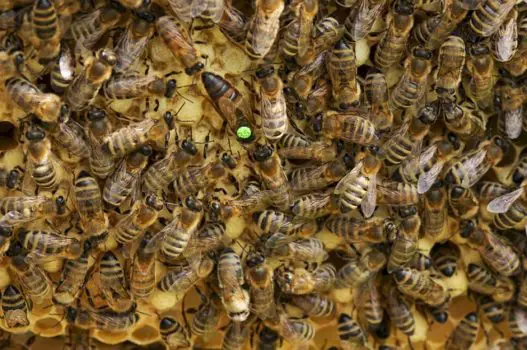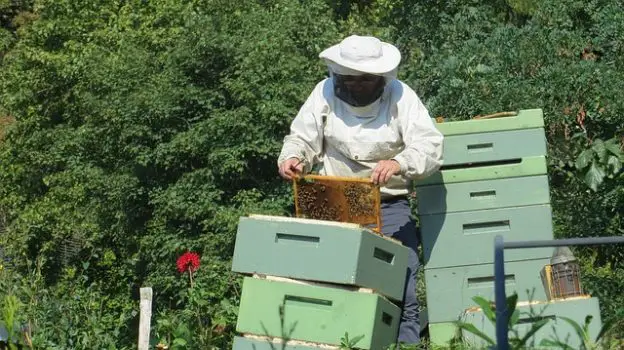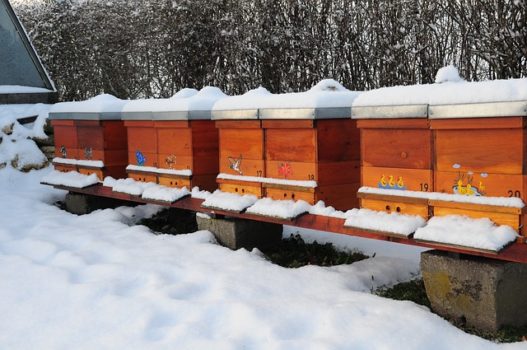A major concern of many, if not all beekeepers is the wintering over of their bees. The winter can take a huge toll on the hive and sometimes result in the death of your hive.
Saskatraz bees are a great variety to work with. I have kept them for one year now. They wintered very well and seem to be doing great for this next season. There are a few people who have reported that their Sascatraz bees were prone to swarming in the spring however.
A little bit about the Saskatraz honey bees.
The Saskatraz honey bee is a relatively newer variety or race that has become commercially available to the hobby/backyard beekeeper. They were developed in a vigorous and meticulous program. The bees were chosen from several distinct areas around the world where certain bee colonies exhibited desirable traits to be bred into a new honey bee race.
The regions included Russia, Germany, and parts of Canada. All the varieties were well adapted to colder winter conditions. The wintering-over traits found in these different colonies were bred into the Saskatraz honey bee. This has made the Saskatraz a relatively hearty bee for areas with colder longer winters.

Many other positive traits were bred into the Saskatraz honey bee. In fact, these other traits were the main focus of the Sakatraz project. I have an article here discussing the Saskatraz bee. It was a fascinating study and project to come up with the Saskaraz bee.
Why are wintering honey bees even something to worry about?
You may have thought that honey bees just hibernate through the winter and then wake up in the spring with no ill effects. This isn’t the case however. Honey bees stay alive and active through the winter. They don’t venture out of the hives unless it’s about 42.7 degrees F. Even then, it’s only for a cleansing flight to clear out their digestive tract.
When the temperature gets below 55 degrees F the hive will cluster up to conserve and create heat. The bees will shiver their muscles and keep the center of the cluster warm. The cluster surrounds the queen to keep her safe and warm. If the temperature of the cluster gets below 41 degrees F then bees will die. If there are not enough bees to keep the queen warn she will die as well. With no queen the colony will not function properly, and you can lose the whole hive.
Problems that arise with wintering honey bees.
There are some serious issues that can show up during winter beyond the cold that can kill honey bees. One of which is the genetic predisposition to a warmer climate. Some races of honey bees have been raised in less severe winter climates and have adapted to that. Taking these varieties into areas of a more severe winter can result in extra stress on a bee colony and result in death. This is one reason that not many Africanized honey bees are found in colder climates. The Africanized queens don’t survive the cold very well at all.
Most honey bees are prone to problems from parasites. Two of the major pericytes that beekeepers deal with are the varroa mite and the tracheal mite. These are two lousy pericytes that can destroy colonies that have been healthy and produced well for years.
During the winter months as the bees’ cluster up, the mites will go from host bee to host bee, making bees sick and killing them. The honey bees are already under stressful conditions, and the added stress of the mites can kill the bees quickly.
Another wintering problem can be improper beekeeping practices. When you are harvesting honey, it’s tempting to take as much as you dare, and maybe even a little more. I have heard the phrase of a beekeeper being too greedy. When you are too greedy and take too much of the colonies store of honey, they don’t have enough to stay alive and keep the queen safe and warm. A beekeeper, in effect can starve a hive to death.
Another poor beekeeping practice is not keeping the hive dry inside. When a hive is tipped or sealed up in a way that traps water in it creates problems. Mold, fungus, and mildew can build up. This creates sickness and disease in the hive which can stress the hive beyond just the cold of winter and kill the colony.
Sometimes a hives location can be a problem. If you have a hive that is in a constant wind the temperature can get extreme and just plain freeze the bees. Thinking ahead of a sheltered wintering place can really help in the winter survival of the honey bee.
Saskatraz honey bees are great for winter survival.
Saskatraz bees have cold hearty genetics as I discussed before. It’s amazing to live in time where the genetics of Russian, German, and Canadian bees can be brought together to get a strong bee variety that can winter well. Here is the whole official website of the Saskatraz honey bee project. It has all the technical information and some power point presentations.
Another really great genetic trait that the Saskatraz honey bee has is their resistance to varroa and tracheal mites. The bees selected for the Saskatraz project were specifically chosen for their traits of mite resistance. It’s interesting how they chose these colonies to work from and how meticulous they were in producing the Saskatraz variety. Again, here is the article I discuss it. Here is a link to the official Sascatraz project site.
The Saskatraz honey bee has also shown good resistance to some of the major fungal and viral issues that are facing beekeepers. These bees have shown good hygienics, meaning that they keep the hive and themselves clean. This creates less opportunity for fungus and viruses to spread or even get started.
A big issue that Saskatraz bees can’t overcome.
One thing that Saskatraz bees cannot overcome through winter is poor beekeeping practices. This is where a beekeeper might have limited knowledge on what to do to prepare a hive for winter. Sometimes a beekeeper is overwhelmed and just can’t get everything in order before winter arrives. Sometimes a beekeeper is just plain negligent or lazy. This is where a lot of problems can arise and create problems that can spread to other apiaries.
A good practice is to have plenty of full frames of honey for the bees to survive on. How much honey your hive needs is dependent on the climate you are keeping your bees in. The longer and colder your winters are, the more honey your bees will need. I live in norther Utah where it gets cold with a good amount of snow. I generally try to have 7-9 full frames of honey available for the bees in their hive for winter.
It’s also good practice to check on the bee bread. The bees will need sufficient protein to survive the winter as well. You may need to add a pollen patty to aid your hive to get the protein content up. Generally, you add pollen patties in the fall or spring. You don’t want to open up the hive in the winter if at all possible.

Please gain as much knowledge as you can when beekeeping. The more you learn the better and easier you can take care of honey bees. Also, don’t bite off more than you can handle. Many people have big ideas about how many hives and bees they can take care of. Really assess your resources and the time you have available when keeping honey bees.
Saskatraz honey bee wintering summary.
Saskatraz honey bees really are great at wintering over. They have been bred from good wintering stock from colder climates. They have great traits for winter survival, mite resistance, and fungal and viral resistance. They are over all a great honey bee to consider if you have cold winters.
Please remember that Saskatraz honey bees can’t overcome poor beekeeping practices. Poor beekeeping cannot be overcome by any honey bee no matter how great the genetics are. Take care of them well, and the Saskatraz honey bee will winter well.

